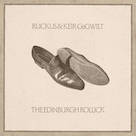

Ruckus and Keir GoGwilt: The Edinburgh Rollick
Ruckus Records
Issued on the NYC-based ensemble's own label, the early music baroque outfit Ruckus partners on its sophomore album with Scottish violinist Keir GoGwilt for an invigorating presentation of music by Niel Gow, a Perthshire-born Scottish fiddler who lived from 1727 to 1807. Compiled by GoGwilt, who was born in Edinburgh but grew up and currently lives in New York City, The Edinburgh Rollick serves up a tantalizing smorgasbord of rousing Celtic dance tunes, with many packaged as dynamic medleys. While the forty-seven-minute album was recorded at Sun Hill Studio in Putney, Vermont in March 2024, its heart beats Scotland when it features an ebullient programme of strathspeys, reels, jigs, and songs.
On its follow-up to Fly the Coop, Ruckus comprises singer and penny whistle player Fiona Gillespie, Paul Holmes Morton on theorbo and baroque guitar, harpsichord and synthesizer player Elliott Figg, Clay Zeller-Townson on baroque bassoon and spoons, percussionist Rami El-Aasser, and Doug Balliett on bass and viola da gamba. Such a wealth of instrumentation enables Ruckus to generate the sonic richness of a chamber ensemble without being so large as to be unwieldy. As carefully as the group hews to charts, its visceral attack amplifies the grittiness and rootsiness of its sound. It ain't polite and genteel, in other words, even though Ruckus is more than capable of playing tenderly too. It's telling that, by its own admission, Ruckus has performed this baroque-folk material in both concert and dance hall settings.
Framing the album are two action-packed suites, The Jenny Sutton Set and The Jenny Nettles Set, the first comprising seven tunes and the second five. Three other sets of slightly less elaborate design appear alongside six more settings on this wide-ranging collection. An always inspired GoGwilt leads the rousing charge, with the raucous Ruckus by his side every step of the way. As one snappy tune follows another, the energy rarely flags and strings, guitars, and spoons kick up their heels, only ever slowing briefly for a lyrical moment.
The Forrest Set begins in lamenting mode with “Lord Elcho's Favorite” before Figg's harpsichord animates “Dunkeld House” and the rest of the ensemble follows suit. Elsewhere, the violinist's attack in The Lord Macdonald Set is infectious, scrappy, and ferocious and sounds more geared for the pub than the formal concert stage. Slightly less furiously relayed are The Gigg Set, whose third part, “Lady Charlotte Murray's Jig,” has been covered by The Chieftans, and “Mrs. Ferguson's Strathspey.” Adding to the arresting impact of the performances are the baroque bassoon and viola da gamba timbres Zeller-Townson and Balliett respectively contribute to the band's sound (the ear understandably picks up when bassoon, viola da gamba, and harpsichord take turns introducing “Robie Dona Gorach”). The Edinburgh Rollick moves into vocal song territory when Gillespie elevates “Lord Gregory” with florid acrobatics perfectly tailored to the ballad-drone tone of the song; as affecting is her moving delivery in “The Broome of Coudenknowes.”
GoGwilt's liner notes provide a vivid portrait of Gow and his time, clarifying, for example, that it was his son, Nathaniel, who was responsible for assembling and publishing the Neil Gow collections in Edinburgh around the turn of the nineteenth century. GoGwilt also notes that while Scottish music is typically branded “folk,” the Gow collections are marked by classical elements such as a continuo bass line and instruments like the harpsichord and cello; that the tunes were also notated distances them from others handed done informally from one generation to the next. Considerable attention is given to the lineage of certain tunes in the collection and their origins, but such details, while interesting and of value, are secondary to the ample pleasures the music itself affords. At a certain point, it's best to stop reading and start listening, especially when the performances are as authentic and spirited as they are here.May 2025